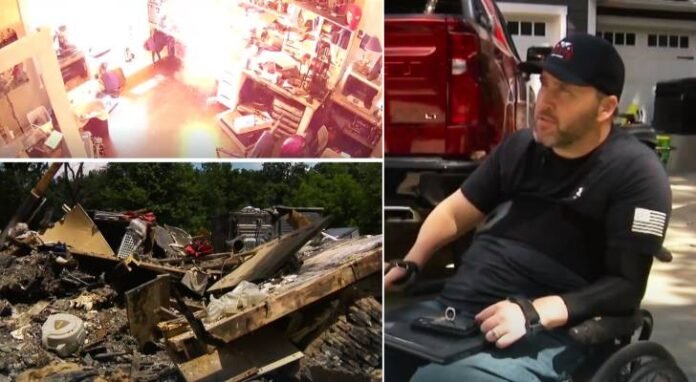Dustin Harpe built his family’s dream home in Kenosha County, Wisconsin: a space where his kids could grow up and where he could thrive as a father with quadraplegia.
But that dream turned to disaster this month when a fire sparked by a lithium-ion drone battery ripped through the house, leveling it in less than an hour.
“I didn’t think a battery that size would take my house down in 45 minutes,” Harpe told local station TMJ4.
Now Harpe is sharing his story with a plea: “Take precautions to protect your family.”
Don’t miss
Why lithium-ion batteries can be dangerous
Lithium-ion batteries — found in drones, smartphones, e-bikes, and power tools — are lightweight, rechargeable, and power much of our modern life. But when damaged, overheated or poorly manufactured, they can become ticking time bombs.
Fire officials and consumer safety advocates agree. Richard Trumka, a commissioner with the U.S. Consumer Product Safety Commission (CPSC), recently released a statement warning of the escalating risk:
“People in apartment buildings are worried that their neighbor’s e-bike could burn down the entire building. And that’s not a hypothetical concern…it’s happening. A fire broke out on the 20th floor of a 37-story New York apartment building. It hurt 43 people, and for those living in floors above the fire, firefighters had to repel down from the roof to save them through their windows.”
The CPSC has logged 227 fire-related incidents linked to lithium batteries in micromobility products alone — leading to 39 deaths and 181 injuries. But proposed safety regulations to address the issue are currently stalled, after the agency’s Democrat majority was ousted in May 2025 and remaining Republican commissioners voted to withdraw the rule in its current form.
Experts warn that the biggest risks of fire or explosion come from:
-
Overcharging or unattended charging
-
Low-quality or uncertified batteries
-
Improper storage in hot garages or near flammable items
-
Damaged, swollen or counterfeit battery cells
CPSC officials urge consumers to use only batteries and chargers certified by labs such as UL or ETL, follow manufacturer guidelines for storage and charging carefully, and avoid cheap aftermarket substitutes.
Read more: Americans are ‘revenge saving’ to survive — but millions only get a measly 1% on their savings. Here’s how to quickly earn 280% more on your cash
No time to react
After an accident nine years ago left him with quadriplegia, Harper was very lucky that he decided to leave the house that day.
“I was really close to just getting back in bed because I wasn’t feeling very good. I don’t know what made me change my mind,” Harpe said. “If I’m stuck in bed by myself I’m like a turtle on my back, you know, I can’t get up or get out.”
His wife and their four children were not home when the fire broke out, but the home — designed to be fully accessible for Harpe’s wheelchair — was completely destroyed. Their three pets did not survive the flames.
How to protect yourself from lithium battery fires
Harpe says he never thought a drone battery could do this kind of damage.
“It’s not something that I think most people think about, that something that small can cause a problem that big,” Harpe said. And he’s right, most consumers don’t realize how dangerous lithium batteries can be if not handled with care.
Here’s how to reduce the risk in your own home:
-
Never charge lithium batteries unattended, especially while sleeping or away from home.
-
Avoid extreme temperatures. Don’t leave batteries in hot garages or cars.
-
Use fireproof storage or charging bags for drones, e-bikes, or tool batteries.
-
Look for damage. If a battery is swollen, hot, or smells odd, stop using it immediately.
-
Charge in a safe area. Keep batteries away from flammable items, wood, paper, or gasoline.
-
Keep a fire extinguisher nearby — especially in garages or home workshops.
Experts typically also recommend charging batteries like these outside if possible, in shaded areas like a shed in the backyard. It’s also a great idea to charge them inside of fireproof bags or in non-flammable spaces.
As for Harpe, he plans to rebuild a new home once the debris of his old one is cleared — focusing on fire protection measures.
What to read next
Stay in the know. Join 200,000+ readers and get the best of Moneywise sent straight to your inbox every week for free. Subscribe now.
This article provides information only and should not be construed as advice. It is provided without warranty of any kind.
